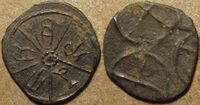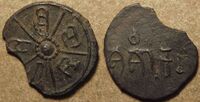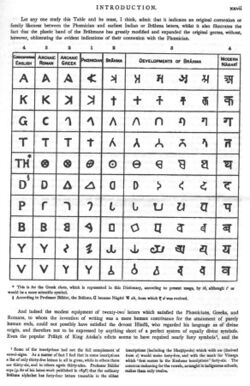Social:Kadamba alphabet
This article includes inline citations, but they are not properly formatted. (October 2013) (Learn how and when to remove this template message) |
| Kadamba | |
|---|---|
| Type | Abugida
|
| Languages | Kannada, Telugu, Sanskrit, Konkani, Marathi |
Time period | 5th century-10th century |
The Kadamba script (known as Pre Old Kannada script) marks the birth of a dedicated script for writing Kannada. It is a descendant of the Brahmi script, an abugida[1] visually close to the Kalinga alphabet.[2] The Kadamba script was developed during the reign of the Kadamba dynasty in the 4th–6th centuries. The Kadamba script is also known as Pre-Old-Kannada script. This script later became popular in what is today the state of Goa and was used to write Sanskrit, Kannada, Konkani and Marathi.
The Kadamba script is one of the oldest of the southern group of South Asian scripts that evolved from the Brahmi script. By 5th century CE it became different from other Brahmi variants and was used in southern Indian states of Karnataka and Andhra Pradesh. It evolved into the Old Kannada script by the 10th century CE and was used to write Kannada and Telugu.[3][4]
Many scripts were derived from Kadamba script, including the Pyu script.
History
During the rule of Kadamba dynasty (325-550), major change in the Brahmi script resulted in the Kadamba Kannada script, letters were shorter and round in shape. During (325 to 1000 AD) the rule of Ganges southern parts of Karnataka the Kannada script used differently (also known as Ganga script) in rock edicts and copper plate inscriptions. During 6th to 10th century, the Telugu-Kannada alphabet stabilized during the rule of the Chalukyas of Badami from 500-1000.[5]) and Rastrakutas.[6]
The Old Kannada ("Halekannada") alphabet is the continuation of the Telugu-Kannada alphabet used to write Kannada and Telugu.[7]
Brahmi -> Kadamba -> Old Kannada -> Kannada and Telugu scripts[8]
Similar scripts
Goykanadi, Bhattiprolu script, Salankayana script,[9] Pallava script and Gupta script[10] a family of alphasyllabaries or abugidas has some similarity.[11]
Sinhala script is closely related to Grantha script and Old Khmer script[12] (closely related to Kadamba-Pallava script) taken the elements from Kadamba script.[13]
Indian Writing Systems Comparison:[14]
Kadamba-Pallava script
During the rule of Pallavas, the script accompanied priests, monks, scholars and traders into South East Asia. Pallavas developed a script based on Brahmi, main characteristics of the newer script are aesthetically matched and fuller consonant glyphs. Similar to Pallava script, also visible in the writing systems of Chalukya,[15] Kadamba, Vengi at the time of Ikshvakus. Brahmi design iwas slightly different of the scripts of Cholas, Pandyas and Cheras. Pallava script very first significant developments of Brahmi in India, take care in combining rounded and rectangular strokes and adding typographical effects, was suitable for civic and religious inscriptions. Kadamba-Pallava script[16] evolved into early forms of Kannada and Telugu scripts. Glyphs become more rounded and incorporate loops because of writing upon leaves and paper. The scripts which are descended from the Kadamba-Pallava script are Pyu script,[17] Burmese, Mon, Kawi, Lanna, Tham, Khom, Khmer, Thai, Lao, Sinhalese and Tai Lue.[18][19]
Inscriptions in Kadamba script
- Inscription of 4th Century AD of Vengi Vijayanandivarma in Kadamba script[20]
- Gudnapur Inscription on 20-foot long stone pillar written in Kadamba script[21]
- Copper plate inscriptions in Kadamba (Pre - Chalukya) script, Kadamba-Pallava script, Kannada-Telugu script are available at Chennai museum[22]
See also
- Abugida
- Ancient Philippine scripts
- Bhattiprolu script
- Goykanadi
- Gupta script
- Kalinga script
- Kannada alphabet
- Old Kannada
- Palaeography-Kannada
- Pallava script
- Pyu script
- Telugu alphabet
- Kannada-Telugu script
References
- ↑ "Types of Writing Systems". Ancient Scripts. http://www.ancientscripts.com/ws_types.html. Retrieved 2014-03-13.
- ↑ "Kalinga". Ancient Scripts. http://www.ancientscripts.com/kalinga.html. Retrieved 2014-03-13.
- ↑ "Scripts fading away with time". http://www.bangaloremirror.com/index.aspx?page=article§id=11&contentid=201108192011081918523431228d487a3. Retrieved 2013-08-28.
- ↑ "Kadamba script". http://www.ancientscripts.com/kadamba.html. Retrieved 2013-08-28.
- ↑ Kipfer, Barbara Ann (2000). Encyclopedic Dictionary of Archaeology. Springer Science & Business Media. p. 692. ISBN 978-0-306-46158-3. https://books.google.com/books?id=XneTstDbcC0C&pg=PA692.
- ↑ "A BRIEF HISTORY OF EVOLUTION OF KANNADA SCRIPTS". http://www.indianscripts.com/Articles/A-BRIEF-HISTORY-OF-EVOLUTION-OF-KANNADA-SCRIPTS.html. Retrieved 2013-08-28.
- ↑ "Old Kannada". http://www.ancientscripts.com/old_kannada.html. Retrieved 2013-08-28.
- ↑ "South Asian Writing Systems". Ancient Scripts. http://www.ancientscripts.com/sa_ws.html. Retrieved 2014-03-13.
- ↑ http://www.skyknowledge.com/brahmi-pallava.jpg
- ↑ "Gupta". Ancient Scripts. http://www.ancientscripts.com/gupta.html. Retrieved 2014-03-13.
- ↑ http://qph.is.quoracdn.net/main-qimg-b89c2602830ce52943cc344ea425b043
- ↑ http://learnkhmer.net/Oldkhmerinvitationrev.jpg
- ↑ "Sinhala script". 2012-08-31. http://www.ancientscripts.com/sinhala.html. Retrieved 2013-08-28.
- ↑ "South Asian Writing Systems Comparison". Ancient Scripts. http://www.ancientscripts.com/sa_ws_cmp.html. Retrieved 2014-03-13.
- ↑ http://www.skyknowledge.com/burnell-plate4.gif
- ↑ "Pallava script". Skyknowledge.com. 2014-02-02. http://www.skyknowledge.com/pallava.htm. Retrieved 2014-03-13.
- ↑ http://lionslayer.yoeyar.com/wp-content/uploads/2011/05/Pallava-a-Pyu-equivalent-script.jpg
- ↑ "Pallava - an important ancient script from South India". http://www.skyknowledge.com/pallava.htm. Retrieved 2013-09-05.
- ↑ Jayarajan, Paul M. (1976-01-01) (in en). History of the Evolution of the Sinhala Alphabet. Colombo Apothecaries' Company, Limited. https://books.google.com/books?id=fcQSAAAAMAAJ.
- ↑ http://www.skyknowledge.com/vengi-4thC-specimen.jpg
- ↑ Rajiv Ajjibal (2011-12-16). "Monuments crying for attention". The Hindu. http://www.thehindu.com/todays-paper/tp-national/tp-karnataka/monuments-crying-for-attention/article2719672.ece. Retrieved 2014-03-13.
- ↑ "Government Museum Chennai". Chennaimuseum.org. http://www.chennaimuseum.org/draft/gallery/01/07/copper2.htm. Retrieved 2014-03-13.
External links
- Evolution of Kannada script
- story of Indian scripts - Evolution
- Chalukya Kannada script 690 AD
- Chalukya Kannada script 578 AD
- Vengi Kannada script 4th century AD
- Pyu script Pallava a Pyu equivalent script
- Ancient scripts timeline - Kadamba scripts
- Indus writing is multilingual: a part-syllabic system at work
- Indian Scripts -Brahmi to Devanagari
- South Asian Writing Systems
- Development of Brahmi script, second column is Kadamba script
- Kannada is older than Tamil script
- Coins of Kadambas os Banavasi
- Comparison of Brahmi and Kadamba-Pallava script (Salankayana script)
- Evolution of Telugu Character Graphs
- Important Discoveries in the recent past Andhra Pradesh









